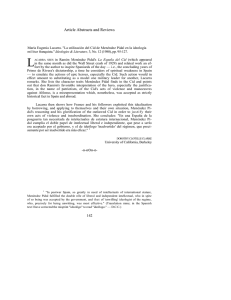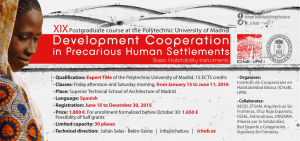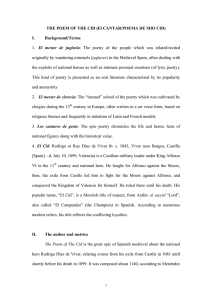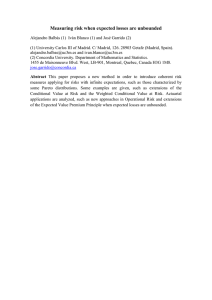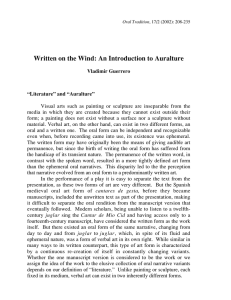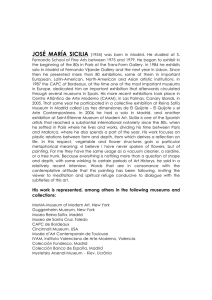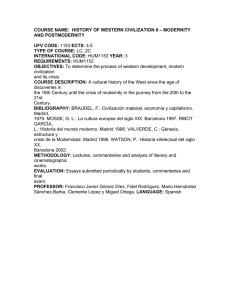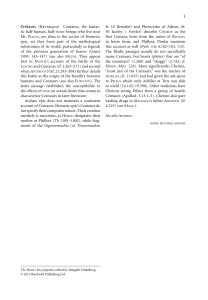Epic and Ballad: A Traditionalist Perspective
Anuncio
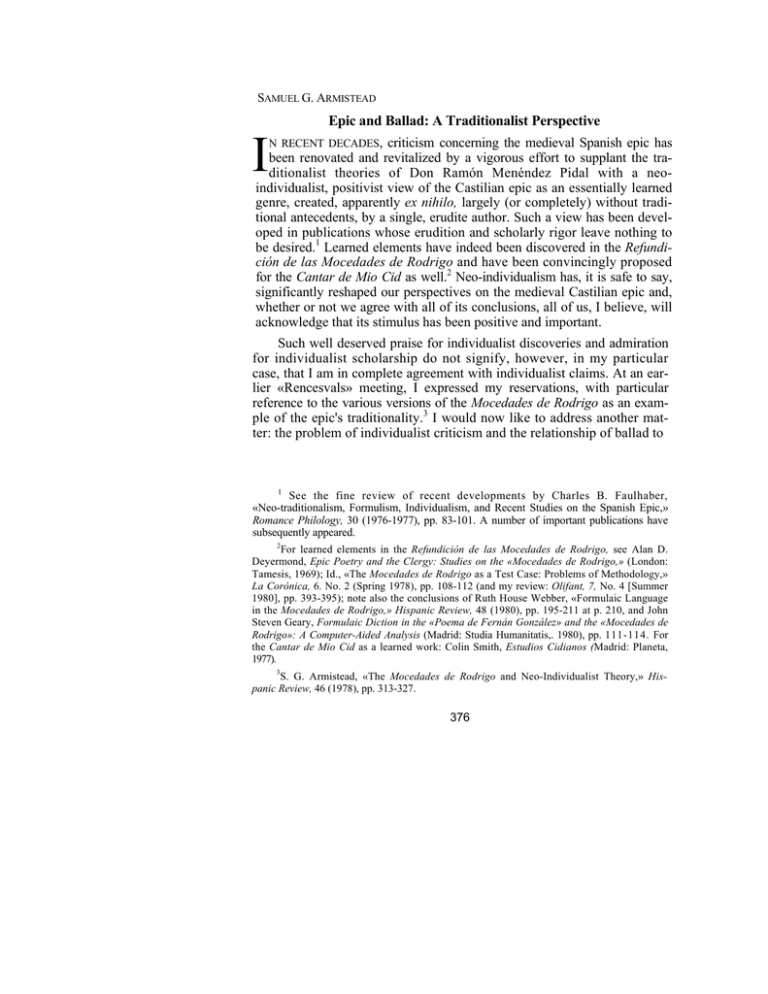
SAMUEL G. ARMISTEAD I Epic and Ballad: A Traditionalist Perspective N RECENT DECADES, criticism concerning the medieval Spanish epic has been renovated and revitalized by a vigorous effort to supplant the traditionalist theories of Don Ramón Menéndez Pidal with a neoindividualist, positivist view of the Castilian epic as an essentially learned genre, created, apparently ex nihilo, largely (or completely) without traditional antecedents, by a single, erudite author. Such a view has been developed in publications whose erudition and scholarly rigor leave nothing to be desired.1 Learned elements have indeed been discovered in the Refundición de las Mocedades de Rodrigo and have been convincingly proposed for the Cantar de Mio Cid as well.2 Neo-individualism has, it is safe to say, significantly reshaped our perspectives on the medieval Castilian epic and, whether or not we agree with all of its conclusions, all of us, I believe, will acknowledge that its stimulus has been positive and important. Such well deserved praise for individualist discoveries and admiration for individualist scholarship do not signify, however, in my particular case, that I am in complete agreement with individualist claims. At an earlier «Rencesvals» meeting, I expressed my reservations, with particular reference to the various versions of the Mocedades de Rodrigo as an example of the epic's traditionality.3 I would now like to address another matter: the problem of individualist criticism and the relationship of ballad to 1 See the fine review of recent developments by Charles B. Faulhaber, «Neo-traditionalism, Formulism, Individualism, and Recent Studies on the Spanish Epic,» Romance Philology, 30 (1976-1977), pp. 83-101. A number of important publications have subsequently appeared. 2 For learned elements in the Refundición de las Mocedades de Rodrigo, see Alan D. Deyermond, Epic Poetry and the Clergy: Studies on the «Mocedades de Rodrigo,» (London: Tamesis, 1969); Id., «The Mocedades de Rodrigo as a Test Case: Problems of Methodology,» La Corónica, 6. No. 2 (Spring 1978), pp. 108-112 (and my review: Olifant, 7, No. 4 [Summer 1980], pp. 393-395); note also the conclusions of Ruth House Webber, «Formulaic Language in the Mocedades de Rodrigo,» Hispanic Review, 48 (1980), pp. 195-211 at p. 210, and John Steven Geary, Formulaic Diction in the «Poema de Fernán González» and the «Mocedades de Rodrigo»: A Computer-Aided Analysis (Madrid: Studia Humanitatis,. 1980), pp. 111-114. For the Cantar de Mio Cid as a learned work: Colin Smith, Estudios Cidianos (Madrid: Planeta, 1977). 3 S. G. Armistead, «The Mocedades de Rodrigo and Neo-Individualist Theory,» Hispanic Review, 46 (1978), pp. 313-327. 376 Armistead / Epic and Ballad 377 epic or, as a traditionalist might put it, the ballad as a surrogate witness to the traditional nature of the epic. Individualist criticism has tended to play down the possible relationship of the Hispanic ballad to the medieval Castilian epic. William J. Entwistle, in whose writings we can detect various ideas later to be developed by individualist critics, could never quite accept Menéndez Pidal's traditionalist theory that ballads developed from fragmented epics.1 In the excellent introduction to his critical edition of the Cantar de Mio Cid, Colin Smith argues that «the mechanism by which material passed from epic to ballad is far from being well understood.»2 In an article published in 1970, John G. Cummins set up impossible requirements—requirements that could, under no circumstances, ever be met—as a prerequisite for demonstrating that any ballad could be derived from an epic. Cummins seems to believe that we would have to discover a ballad that agreed in all particulars with some known epic before the theory of epic fragmentation could even be considered.3 According to Cummins: «The absence of bal1 William J. Entwistle, European Balladry (Oxford: Clarendon, 1951), pp. 167-169. 2 C. Smith, ed., Poema de Mio Cid (Oxford: Clarendon, 1972), p. xvii; 2nd., Spanish ed. (Madrid: Cátreda, 1976), p. 21. 3 John G. Cummins, «The Creative Process in the Ballad Pártese el moro Alicante,» Forum for Modern Language Studies, 6 (1970), pp. 368-381. Cummins's requirements imply an impossibility: «Unless some ballad emerges which shows close similarities to an epic without such accompanying evidence of re-creation, the foundations under the theory of epic disintegration will remain shaky» (p. 381; italics mine). Cummins seems to think that, according to neo-traditionalism, «the step from epic to romance was . . . casual and accidental» (p. 381), some sort of automatic, will-less, biological decomposition, in which conscious, aesthetic choice had no part at all. But according to neo-traditionalism, the peak points of an epic narrative would have been selected, chosen by individuals in the juglar's audience, to be sung separately as potential, future ballads, precisely because they were dramatic and particularly attractive from an artistic point of view. This is the whole point of Menéndez Pidal's theory. We are not working in oral literature with some sort of biological determinism. Epic «fragmentation» was a positive, creative, poetic act. And any epic fragment, in the processes of its transformation into an autonomous ballad, would begin, almost immediately, to acquire distinctive characteristics of its own, even from the very first moment of its new, independent career as a proto-romance. In the light of Paul Bénichou's findings concerning creativity in traditional balladry (Creación poética en el romancero traditional [Madrid: Gredos, 1968]). Cummins's requirements become meaningless. The word «fragmentation,» like «contamination,» has passive, negative connotations, but it must be seen rather as a process involving an active, positive aesthetic decision on the part of the listener who has decided to become a singer. For a succinct formulation of Menéndez Pidal's fragmentation theory, see La epopeya castellana a través de la literatura española, 2d ed. (Madrid: Espasa-Calpe, 1959), p. 139. On the creativity of contamination, see J. H. Silverman, «La contaminación como 378 Olifant / Vol. 8, No. 4 / Summer 1981 lads with sufficient similarities to a corresponding epic to support [Menéndez Pidal's] theory has been widely realised.»1 Again, the collection of essays, many of them excellent, brought together by N. D. Shergold in 1972, is strongly individualist in orientation and avoids «the familiar topics of epic origins or popular transmission» in favor of viewing the ballad as an essentially learned genre.2 In this same volume Colin Smith's splendid study on «The Ethos of the Romancero viejo,» a fundamentally important contribution to ballad scholarship, tends, however, to view early Spanish balladry as a fixed, established corpus, «created in the 15th and early 16th centuries» and limited essentially to Martín Nucio's Cancioneros, the Silva, and Timoneda.3 Though Smith does draw occasional comparisons with ballads from modern tradition, individualism has generally eschewed the study of the modern Romancero, especially as it may throw light upon the problem of epic-ballad relationships and the possible traditionally of both genres. It is to this problem that I would like to speak today. Evidence of epic-derived ballads in the sixteenth-century tradition is, in the first place, far from scanty. Such old Primavera favorites as Castellanos y leoneses (Primav. 16), Yo me estaba en Barbadillo (19), Pártese el moro Alicante (24), Cabalga Diego Laínez (29), Cada día que amanece (30; 30a-b), A Concilio dentro en Roma (34; 33), Doliente estaba, doliente arte en un romance sefardí de Tánger,» El Romancero hoy: Poética, ed. Diego Catalán et al., (Madrid: C.S.M.P., 1979), pp. 29-37. There seems to be a basic misconception in individualist thought concerning the impossibility of poetic artistry and of individual creativity in traditional poetry. Oral composition is not a random, passive, automatic process. Men composed literature long before— many millenia before—they could write. Oral poetry is art. The unity of the Cantar de Mio Cid is no argument against its traditionally. It is amusing to see how David Mackenzie claims that I «miss the point» concerning the Mocedades and neo-individualism: «Surely what is being said is that, since what we have are learned compositions, . . . it is quite proper to study them as works of art in their own right» (Year's Work in Romance and Celtic Languages and Literatures, 1978, reprinted from Year's Work in Modern Language Studies, 40). By inference, then, if, conversely, what we have are traditional compositions, it would seemingly be improper to study them «as works of art in their own right»! 1 Cummins, p. 368. Here, of course, we might well ask: What do we mean by «sufficient similarities»? 2 N. D. Shergold, ed., Studies of the Spanish and Portuguese Ballad (London: Tamesis, 1972); see my review-article, «Neo-Individualism and the Romancero,» Romance Philology, 33 (1979-1980), pp. 172-181. 3 Colin Smith, «On the Ethos of the Romancero viejo.» Studies of the Spanish and Portuguese Ballad, pp. 5-24, at p. 6. Armistead / Epic and Ballad 379 (35-36), Rey don Sancho, rey don Sancho (44-45), En Santa Gadea de Burgos (52), and Tres cortes armara el rey (59) can all best be explained through direct reference to epic tradition.1 In addition, RodríguezMoñino has discovered a ballad on the enfances of Fernán González, En Castilla no había rey, which cannot be traced to any known chronicle or chronistic prosification and is very probably based upon an epic source.2 In the preceding enumeration, we have, then, all the major national cantares de gesta represented: Fernán González, Infantes de Lara, Mocedades de Rodrigo, Partición de los reinos, Cerco de Zamora, Jura de Santa Gadea and Cantar de Mio Cid. A British Library MS version of En Santa Gadea de Burgos has even preserved for us, as an epilog, a ballad rendition of the most famous epic verses in all of Spanish literature: the initial verses of the Cantar de Mio Cid. This British Library version ends with the following 1 On epic fragments in the early Romancero: R. Menéndez Pidal, Romancero hispánico, 2 vols. (Madrid: Espasa-Calpe, 1953), I, pp. 188-237; in particular, for Castellanos y leoneses (Primav. 16), p. 221; Yo me estaba en Barbadillo (19, vv. 57 ff.), pp. 201-202; Pártese el moro Alicante (24), pp. 203-206; Cabalga Diego Laínez (29), pp. 220-221; Coda día que amanece (30, 30a-b), p. 219; A concilio dentro en Roma (33-34), pp. 215-218; Doliente estaba, doliente (35-36), pp. 213-215; Rey don Sancho, rey don Sancho (44-45), pp. 200-201; Tres cortes armara el rey (59), pp. 222-224; En Santa Gadea de Burgos (52); R. Menéndez Pidal, Estudios sobre el Romancero (Madrid: Espasa-Calpe, 1973), pp. 89-106. (The abbreviation Primav., used here and elsewhere in this article, refers to Fernando José Wolf and Conrado Hofmann, Primavera y flor de romances, 2 vols. [Berlin: A. Asher, 1856]). As Diego Catalán has shown, when in exceptional cases we possess manuscript evidence prior to the texts printed and widely diffused in the cancioneros, we are invariably confronted with a text which is closer, in both style and content, to epic tradition. (See D. Catalán, «Memoria e invención en el Romancero de tradición oral,» Romance Philology, 24 [1970-1971], pp. 1-25. 441-463 at p. 454 and note 1 1 1 . ) The irregular metrics of the earliest romances, which are not consistently octosyllabic, but show some verses of nine, seven, and even six syllables, also clearly reinforces their close relationship to the anisosyllabic epic. (See Romancero hispánico, I, pp. 86-88.) Even the radical differences between the early Romancero and its modern derivatives, inasmuch as such differences can be shown to form part of a continuum whose components grow ever mote distant and ever more different from their epic origins, still serve to demonstrate the essential oneness of epic and ballad in the Hispanic tradition. On fundamental differences between early and modern versions of the same ballad, see Diego Catalán's studies of Búcar sobre Valencia, in Siete siglos de Romancero (Madrid: Gredos, 1969), pp. 133-215, and of Don Manuel y el moro Muza, in «El romance tradicional, un sistema abierto,» El Romancera en la tradición oral moderna, ed. D. Catalán et al. (Madrid: C.S.M.P., 1973), pp. 181-205 (with the collaboration of Teresa Catarella). 2 A. Rodríguez-Moñino, La transmisión de la poesia española en los siglos de oro (Barcelona: Ariel, 1976), pp. 237-210; R. Menéndez Pidal et al., Romancero tradicional de las lenguas hispánicas, II (Madrid: Gredos, 1963), pp. 282-290. 380 Olifant / Vol. 8, No. 4 / Summer 1981 lines: Ya se partía el buen Cid de Bivar, esos palaçios. Las puertas dexa cerradas, los alamudes echados, las cadenas dexa llenas de podencos y de galgos. Con él lleva sus halcones, los pollos y los mudados. Con él van çien cavalleros, todos eran hijos de algo; los unos ivan a mula y los otros a cavallo; por una ribera arriba al Çid van acompañando; acompañándolo ivan, mientras él iva caçando.1 These splendid verses, with their characteristic combination of verbal correspondences (de Bivar; palacios; puertas cerradas/abiertas; halcones . . . mudados) and radical departures from their epic source, cannot be an independent, individual creation; they cannot be inspired in some chronistic intermediary; and they cannot be derived from Per Abbat's copy. As Menéndez Pidal has shown, they can only be a re-elaboration, through oral transmission, of the traditional initial episode of the Cantar de Mio Cid. Individualism has tended to pass over in silence another crucially important body of Spanish epic material. I am referring to epic narratives in Spanish on French, Carolingian themes. To be sure, the French epic itself looms big in individualist criticism. Ian Michael even believes that the Cid poet must have «learned the techniques of epic form and style» from hearing French heroic poetry recited along the pilgrim route to Santiago.2 Colin Smith has made extensive use of French material to argue that the author of the Cantar de Mio Cid (Per Abbat himself perhaps?) used a number of chansons de geste as his sources.3 But of actual Spanish 1 Menéndez Pidal, Estudios sobre et Romancero, pp. 92-97; Romancero hispánico, I, pp. 225-226. It is worthy of note that the ballad agrees verbally with both Menéndez Pidal's chronicle-based reconstruction (de Bivar, palacios; vv. 11-12), and with the initial verses of Per Abbat's copy (puertas; halcones . . . mudados; vv. 3, 5). The allusions to Bivar and palacios are, of course, not in Per Abbat and the puertas and halcones mudados are not in the Crónica de Castilla (Chrónica del famoso cavallera Cid Ruydiez Campeador, ed. V. A. Huber [Stuttgart: C. P. Scheitlin, 1853], pp. 96-97). The ballad thus confirms the authenticity of the prosified verses reconstructed by Menéndez Pidal. Concerning MS. Eg. 1875, see now Dorothy Sherman Severin and Angus McKay, eds., Cosas sacadas de la «Crónica del Rey D. Juan II» (Exeter Hispanic Texts [in press]). 2 Ian Michael, ed., The Poem of the Cid (Manchester: University Press, 1975), p. 13; cf. Spanish ed. (Madrid: Castalia, 1976), p. 51. 3 Colin Smith, «Temas carolingios y franceses en el Poema de mio Cid,» Estudios cidianos, pp. 125-160; Id., «Further French Analogues and Sources for the Poema de mio Cid,» La Armistead / Epic and Ballad 381 adaptations of French epic poems individualism has had very little, if anything, to say. This is because, with the notable exception of Roncesvalles, such Spanish Carolingian poems can only be postulated by bringing into play, on the evidence of the Romancero, the concept of «lost texts,» a concept which is, of course, fundamentally repugnant to individualist theory.1 The testimony of the Nota Emilianense has likewise seemingly been discounted. Yet a Carolingian epic did exist in Spain. The Romancero offers us cogent evidence of a whole repertoire of Spanish remaniements of chansons de geste: of Ogier le Danois (in El marqués de Mantua [Primav. 165-167]), of the Chanson des Saisnes (in Valdovinos [168-169]), of Aïol (in Montesinos [175-176]), of Aymeri de Narbonne (in Almerique de Narbona [196]), and, indeed, of the Roland itself (in Domingo era de Ramos, La fuga del rey Marsín, El sueño de doña Alda, and La muerte de don Beltrán [183, 184, 185, 185a]).2 But lest our individualist colleagues still argue that evidence for the epic origins of Hispanic ballads is meager or insignificant, let us now turn to the neglected testimony of the modern tradition. Here, indeed, we will find a number of the same epic narratives we have just mentioned as attested in the early Romancero: Las quejas de Jimena (=Primav. 30, 30a-b), from the Mocedades de Rodrigo, still sung today in Morocco and in the Azores;3 Las quejas de doña Urraca (=36) from the Partición de los Corónica, 6. No. 1 (1977), pp. 14-21. For other perspectives on this problem, see Alan D. Deyermond and David Hook, «The Afrenta de Corpes and Other Stories,» La Corónica, 10, No. 1 (1981), pp. 12-37, and Ruth House Webber, «Historicidad y tradicionalidad en el Cantar de Mio Cid,» Actas del Séptimo Congreso de la Asociación International de Hispanistas, ed. Giuseppe Bellini (Roma: Bulzoni, [1981]), pp. 585-590. 1 That postulating lost versions is to be avoided: Colin Smith, ed., Poema de mio Cid, pp. xix. xxxii-xxxiii; Spanish éd.. pp. 23, 39-40. 2 On Carolingian narratives in the Romancero: Romancero hispánico, I, 244-265; for El marques de Mantua (Primav. 165-167). p. 264; Valdovinos (168-169), pp. 251-256; Montesinos (175-176), pp. 259-261; Almerique de Narbona (196), pp. 257-259; ballads on Roncesvalles (183-185a). pp. 246-251; La fuga del rey Marsin (Ya comienzan los franceses): R. Menéndez Pidal, Textos médiévales españoles: Ediciones críticas y estudios (Madrid: Espase-Calpe, 1976), pp. 68-75. We may note, parenthetically, that the ballad figure, Beltrán confirms the existence of a distinctive Spanish tradition concerning the presence of Bertran, companion of Guillaume d'Orange, at Roncevaux, as already attested by the allusion to Bertlane in the Nota Emilianense. Here, as in many other cases, ballad and epic give mutually supportive evidence of their common traditionality. See Dámaso Alonso, La primitiva épica francesa a la luz de una nota emilianense (Madrid: C.S.I.C., 1954), pp. 11-14, 42-43, 58-61; Juan Baulista Avalle-Arce, Temas hispánicos medievales (Madrid: Gredos, 1974), pp. 124-134. 3 For Las quejas de Jimena (=Primav. 30a-b): S. G. Armistead et al., El romancero 382 Olifant / Vol. 8, No. 4 / Summer 1981 reinos, collected recently in Madeira and Zamora;1 El sueño de doña Alda (=184), from the Provençal Ronsasvals, still sung by Sephardim in North Africa and in the Near East;2 La muerte de don Beltrán, from Portugal and Morocco;3 and Almerique de Narbona, preserved in an exiguous fragment from Salonika:4 But what is even more interesting is that, in numerous other cases, the modern tradition has preserved variants, of indisputably medieval origin, which are unattested in the poems' sixteenth-century counterparts. Such is the case with certain details in the Salonikan Roncesvalles;5 with El rey don Fernando en Francia (from the Mocedades de Rodrigo), as sung today in North Africa;6 with modern versions of Las almenas de Toro, from Trás-os-Montes, Salonika, and Tetuán, which recall complex circumstances of La partición de los reinos and Cerco de Zamora;7 with modern texts of Belardos y Baldovinos, based on a Spanish reworking of the Chanson des Saisnes, which are much more extensive and more detailed than are our sixteenth-century versions and are still sung today in León, Zamora, Santander, Asturias, Trás-os-Montes, and Galicia.8 El destierro del Cid is a relatively late ballad, most of whose components are apparently not directly derived from epic sources, yet judeo-español en el Archivo Menéndez Pidal, 3 vols. (Madrid: C.S.M.P., 1978; abbr. CMP), no. A3; S. G. Armistead, J. H. Silverman, and O. A. Librowicz, Romances judeo-españoles de Tánger (recogidos por Zarita Nahón) (Madrid: C.S.M.P., 1977; abbr. Nahón), no. 1; also Théophile Braga, Cancioneiro popular portuguez (Lisboa: J. A. Rodrigues, 1911), pp. 56-57. 1 For Las quejas de doña Urraca (=36): Joanne B. Purcell, «Recently Collected Ballad Fragments on the Death of Don Fernando I,» Portuguese and Brazilian Oral Traditions in Verse Form, ed. J. B. Purcell et al. (Los Angeles: University of Southern California, 1976), pp. 158-167; D. Catalán, «El romancero de tradición oral en el último cuarto del siglo XX,» El Romancero hoy: Nuevas fronteras, ed. Antonio Sánchez Romeralo et al. (Madrid: C.S.M.P., 1979), pp. 217-256. 2 For El sueño de doña Alda (=184): CMP B6; Nahón 4; S. G. Armistead and J. H. Silverman, The Judeo-Spanish Ballad Chapbooks of Y. A. Yoná (Berkeley; Los Angeles: University of California, 1971; abbr. Yoná), no. 3. 3 For La muerte de don Beltrán (=185-185a): CMP B4. 4 For Almerique de Narbona (=196): CMP B8; Yoná 2. 5 For the Judeo-Spanish Roncesvalles (=183): CMP B3; Yoná 2; S. G. Armistead and J. H. Silverman, Tres calas en el romancero sefardi (Madrid: Castalia, 1979), pp. 122-123. 6 For El rey don Fernando en Francia (=33, 39): CMP A4; Nahón 2; S. G. Armistead and J. H. Silverman, En torno al romancero sefardí: Hispanismo y balcanismo de la tradiciôn judeo-española (Madrid: C.S.M.P., 1982), Chap. I.2. 7 For Las almenas de Toro (=45): CMP A6; Yoná, pp. 40-41. 8 For Belardos y Baldovinos (=168): R. Menéndez Pidal, «La Chanson des Saisnes en España,» Los godos y la epopeya española (Madrid: «Austral,» 1956), pp. 175-209. Armistead / Epic and Ballad 383 Moroccan Sephardic versions have absorbed verses from some variant Cantar de las Mocedades de Rodrigo which are so close to those of the surviving medieval poem that they can even be used to emend two defective lines in the fourteenth-century Refundición.1 Such, then, are some of the cases in which the modern Romancero has preserved important variations of epic themes known also in sixteenth-century Spanish balladry. What is, of course, even more supportive of our traditionalist position is that the modern Romancero has perpetuated, not only some of the same themes known in the sixteenth century (though indeed, as we have just seen, with notable variations in certain cases), but, that the modern tradition has also brought down to us other epic-based narratives, of undoubted medieval origin, which are unknown to us in the printed or manuscript evidence of the fifteenth and sixteenth centuries. Thus we have the Salonikan Sephardic Galiana, a derivative of the Mainet (or Enfances de Charlemagne);2 we have Roldán al pie de la torre, sung in Andalucia, in the Canary Islands, and Sarajevo, and based upon some version of Ogier le Danois;3 we have Floresvento, from the Azores, Trás-os-Montes, and also Morocco, a modern derivative of the Chanson de Floovant;4 and we have Celinos y la adúltera, based on Beuve de Hantone, and sung today in Trás-os-Montes, Zamora, Burgos, Ibiza, and the Sephardic East.5 All of 1 For El destierro del Cid: CMP A9; for the verses in question: Bénichou, Creación poética, p. 16, vv. 17-18, which correspond to vv. 429a-429b of my critical edition of the Refundición de las Mocedades de Rodrigo (in preparation). 2 For Galiana: S. M. Stern, «A Romance on Galiana,» Bulletin of Hispanic Studies, 36 (1959), 229-231; CMP Bl; Yoná, pp. 235-236. 3 For Roldán al pie de la torre: CMP B2. For the connection with Ogier le Danois, I follow unedited notes of R. Menéndez Pidal, generously placed at my disposal by Diego Catalan: In the Judeo-Spanish versions, «el conde Arĝile, patrón de la fuerza mucha» corresponds to Urgel (=Ogier) and there are other details which relate to the French epic. For a modern traditional Andalusian version, see the recording by Antonio Mairena, «Iberia» Records (DIFESCO S.A., Barcelona), AR 1.011, side 2. Cf. also Durán 372; Diego Catalán et al., La flor de la marañuela: Romancero general de las Islas Canarias, 2 vols. (Madrid: C.S.M.P., 1969), II. no. 337. 4 For Floresvento: Romancero hispánico, I, 261-262; R. Menéndez Pidal, «A propósito del Romanceiro português de J. Leite de Vasconcelos,» III Colóquio Internacional de Estudos Luso-Brasileiros, 2 vols. (Lisbon: Impr. de Coimbra, 1959), I, 493-499 at p. 495; José Pérez Vidal, «Floresvento y La esposa infiel,» Douro-Litoral, 9 (1952), 37-40; Manuel da Costa Fontes, «A Sephardic Vestige of the Ballad Floresvento,» La Corónica, 10, No. 2 (1982), 196-201. 5 For Celinos y la adultera: Romancero hispánico, I, 261; Yoná 17; CMP M11; Armistead 384 Olifant / Vol. 8, No. 4 / Summer 1981 these text-types are unattested in the sixteenth century, yet their medieval origins are, we can safely say, beyond dispute. To sum up the traditionalist perspective on epic-ballad relationships, I will simply quote from don Ramón: «Todas las gestas se hicieron romances; es que la epopeya se hizo romancero.»1 In the Hispanic world, epic and ballad constitute a single system of oral, traditional poetry, extending from the epic's remote and unknown origins, in an uninterrupted continuum, down to the twentieth-century tradition of the Romancero. I certainly would not insist that fragmentation of the epics was the only contributory factor in the origin of the Romancero. On one hand, the octosyllable was already widely used in the traditional lyric and, on the other, strophic, non-octosyllabic ballads of the continental European type undoubtedly contributed a generic example, as well as specific themes (Don Bueso y su hermana, among others). Again, I certainly would not insist that all of the ballads I have just mentioned stand in an identical relationship to their epic analogs. I very much believe that the Romancero's, connection with the epic was complex and diversified—a variety of contacts, among which fragmentation was only one possible modality. But what is indubitable is that there is a relationship, a relationship which can be exemplified, in such detail and in such abundance, that it simply cannot be coincidental and it cannot be disregarded. As Dámaso Alonso has observed: The connection between chronicles and epics, epics and ballads is a fact; it is not a theory: «El paso tradicional de los cantares de gesta a los romances épico-líricos está seguramente comprobado.»2 Neoindividualism has not offered us a satisfactory explanation of this phenomenon. To the thoroughly articulated theory of Menéndez Pidal, neoindividualism has proposed no alternative hypothesis. Now this is my point: If indeed the medieval Spanish epic is a learned, individual creation, the invention of a single erudite author; if the Cantar de Mio Cid is the first epic poem, the creation of Per Abbat; if there is no epic tradition; if it is all a learned literary genre; if this is so, then I think we are forced into a very difficult position. Individualists will, I believe, and Silverman, «E1 romance de Celinos: Un testimonio del siglo XVI,» Nueva Revista de Filología Hispánica, 25 (1976), pp. 86-92; Tres calas, pp. 64-77; En torno, Chap. I.3. 1 2 Romancero hispánico, I, p. 193. Dámaso Alonso, «La tradición épica castellana en la obra de Menéndez Pidal (Teoría y hechos comprobados),» La Torre, pp. 18-19 (1970-1971), pp. 15-49 at p. 45. Armistead / Epic and Ballad 385 allow that the Romancero, both early and modern, is essentially traditional in its nature. If this is so—the epic is learned, but the ballad is traditional—then we are faced with the problem, the rather difficult problem, of explaining just how practically all the narratives of a thoroughly learned genre were able, somehow, en masse, to enter oral tradition and be preserved as oral literature. It is easy enough to exemplify the sporadic traditionalization of individual learned works or indeed of learned verse forms: We might cite Lux Aeterna, a poem written by Menéndez Pidal's brother Juan, which is now traditional throughout Spain and in Morocco, Mexico, and Texas;1 or again the learned Golden Age décima, which has become traditional over extensive areas of Hispano-America.2 But that essentially all the narratives of a learned genre should become traditional strains our credibility. How did this happen? Under what circumstances? Why? Of one thing I am reasonably certain: Individualism will never prove, absolutely, its premise, nor will traditionalism either be able to prove that it is right. We are then left with reasonable supposition as our only recourse: Which of our two options is the more probable? Is it more likely that a learned epic would evolve into a traditional ballad? Or rather, is it more likely that the epic, which was to become the traditional ballad, was itself also essentially traditional from the very start? I would not deny that there have been learned influences upon the epic (just as there are, conversely, epic elements in clerical cuaderna vía poetry).3 In this, individualism has proved its point. But that the epic should be considered an essentially learned genre is quite another matter. That all the complex evidence 1 Juan Menéndez Pidal, Poesías (Madrid: «Revista de Archivos, Bibliotecas y Museos,» 1913), pp. 31-37; Jesus Antonio Cid, «Romances en Garganta la Olla,» Revista de Dialectología y Tradiciones Populares, 30 (1974), pp. 467-527: no. 38; Manuel Alvar, Endechas judeoespañolas, 2nd ed. (Madrid: C.S.I.C., 1969), pp. 97-203; Américo Paredes, A Texas-Mexican «Cancionero» (Urbana: University of Illinois, 1976), no. 51. 2 On the décima (among many other studies): Rodolfo Lenz, «Sobre la poesia popular impresa de Santiago de Chile,» Revista de Folklore Chileno, 6, Nos. 1-2 (1919), pp. 33-143; Manuel F. Zárate and Dora Pérez de Zárate, La décima y la copia en Panamá, Panamá: «La Estrella de Panamá,» 1953; Vincente T. Mendoza, Glosas y décimas de México, Mexico City: Fonda de Cultura Economica, 1957; Pedro C. and Elsa M. Escabí, La décima: Estudio etnográfico de la cultura popular de Puerto Rico, Halo Rey: Universsidad de Puerto Rico, 1976. 3 Brian Dutton. «Gonzalo de Berceo and the cantares de gesta,» Bulletin of Hispanic Studies, 38 (1961), pp. 197-205; Id., La «Vida de San Millán de la Cogolla» de Gonzalo de Berceo (London: Támesis, 1967), pp. 175-182. 386 Olifant / Vol 8, No. 4 / Summer 1981 of chronicles and balladry, which militates in favor of the epic's traditional nature, should be set aside, in favor of the theory of the invention of the genre itself precisely by the copyist of the single MS of the earliest known Spanish epic, which just happens to have survived down to the present day—no matter how eloquently and with what admirable erudition it has been argued—goes counter to all the probabilities of early MS transmission. If our Golden Age textual evidence is often exiguous and fragmentary in the extreme; if our critical reconstructions of Golden Age textual transmission have been subject to radical distortions,1 how much more fragmentary, then, must be the testimonies from the Middle Ages and how much greater our possible distortion of that fragmentary evidence? There is so much we do not know; there is so much more yet to be learned. But experience in the study of human phenomena repeatedly shows us that what is most to be expected is the complex rather than the simple; the intricate rather than the straightforward. What bothers me most about a theory of the epic as a learned genre is precisely this: that it is so neat, so tidy, all the problems disappear, and we are left with a single author and a single poem: Per Abbat and the Cantar de Mio Cid. A splendid discovery such as the verses of Zorraquín Sancho, Roldán y Oliveros, recently published by Francisco Rico, shows us how little we really know about the complex origins, the diffusion, and the generic coexistence of medieval poetry.2 Here we have epic and lyric fused into one. This little poem is an eloquent exemplification of the complexity of our problem. A completely learned epic paints us into a theoretical corner. In my view, the situation must have been much more complicated than that, with learned, hagiographic,3 and lyric,4—French, Germanic, Ara- 1 Antonio Rodríguez-Moñino, Construcción crítica y realidad histórien en la poesía española de los siglos XVI y XVll (Madrid: Castalia, 1965), or Critical Reconstruction vs. Historical Reality in Spanish Poetry in the Golden Age (Berkeley: no publisher, 1968). 2 Francisco Rico, «Çorraquin Sancho, Roldán y Oliveros: Un cantar paralelistico del siglo XII,» Homenaje a la memoria de Don Antonio Rodríquez-Moñino (1910-1970) (Madrid: Castalia, 1975), pp. 537-564. 3 John K. Walsh, «Religious Motifs in the Early Spanish Epic,» Revista Hispánica Moderna, 36 (1970-1971), pp. 165-172; for epic influences on hagiography: J. K. Walsh, «French Epic Legends in Spanish Hagiography: The Vida de San Ginés and the Chanson de Roland,» Olifant, 7, No. 2 ( 1979), pp. 157-159, and Hispanic Review, 50 (1982), pp. 1-16. 4 See Alan Deyermond, «Lyric Traditions in Non-Lyrical Genres,» Studies in Honor of Lloyd A. Kasten (Madison, Wisconsin, 1975), pp. 39-52. For more on this, see my «Neo-Individualism and the Romancero,» p. 178 and n. 23. Armistead / Epic and Ballad 387 bic,1 and perhaps also Latin2 influences, all being brought to bear upon an essentially traditional, essentially oral genre. In a recent and splendid book, Ruth Finnegan has shown that diversity, as multiplex as the infinite possible variations of human culture itself, is one of the basic, essential characteristics of oral poetry in a world-wide perspective.3 And contrary to what is usually assumed, the close interaction between oral and written literature is frequently attested in many of the diverse cultural traditions studied by Professor Finnegan. In sum: It is my belief that only a theory which is flexible enough, open enough, to accommodate the diverse factors and multiple currents undoubtedly present in the origins and subsequent development of the medieval epic can hope to explain so complex a problem. The solution cannot lie in a theory which seeks to simplify our perspective, in agreement, solely and precisely, with the exiguous and imperfect manuscript evidence which has survived—fortuitously and by mere chance—down to our own times. Only by our acknowledging the complexity of the problem can it, perhaps, begin to be solved. As work goes forward, I would like to propose the abolition of both «-isms»—traditionalism and individualism—and their replacement by a healthy eclecticism, in a spirit of cordial international collaboration. We are all cultivating the same garden. We must all work together. We would probably not even be here today, discussing these difficult and fascinating 1 See Alvaro Galmés de Fuenties, Epica árabe y épica castellana (Barcelona: Ariel, 1978); cf. my review, Hispanic Review, 48 (1980), pp. 239-241. 2 See H. Salvador Martínez, El «Poema de Almería» y la épica románica (Madrid: Gredos, 1975). 3 Ruth Finnegan, Oral Poetry: Its Nature, Significance and Social Context (Cambridge: University Press, 1977); also pertinent: John D. Smith, «The Singer or the Song?: A Reassessment of Lord's 'Oral Theory',» Man, 12 (1977). pp. 141-153; Roderick Beaton, Folk Poetry of Modern Greece (Cambridge: University Press, 1980), Menéndez Pidal argued, years ago, that the Lordian Yugoslav model need not have also characterized the medieval western European epic. As in so many other cases, subsequent findings, reached from a radically different perspctive, have proved him right. Individualism cannot continue to use the cantares de gesta's relatively low formulaic percentages to negate the epic's traditionally. On Lordian formulism and the Castilian epic, see R. Menendez Pidal, «Los can lores épicos yugoeslavos y los occidentales: El Mio Cid y dos refundidores primitivos,» Boletín de la Real Academia de Buenas Letras de Barcelona, 31 (1965-66), pp. 195-225. On subsequent confirmation of Menéndez Pidal's theories, see my article, «¿Existió un romancero de tradición oral entre los moriscos?» Actas del Coloquio Internacional sobre Literatura Aljamiada y Morisca, ed. Alvaro Galmés de Fuentes (Madrid: Gredos, 1978), pp. 211-236. 388 Olifant / Vol. 8, No. 4 / Summer 1981 matters, were it not for the splendid contributions of our individualist colleagues. To them, then, though we may not agree, we owe our heartfelt thanks for having revitalized our field of endeavor and for having opened up new areas for on-going investigation and discussion.1 SAMUEL G. ARMISTEAD University of California, Davis 1 D. G. Pattison's Theory («The Date of the Cantar de Mio Cid: A Linguistic Approach,» Modern Language Review, 62 [1967], pp. 443-450), so favored by individualism, that the Poem must date from the late twelfth or early thirteenth centuries because of certain supposed pecularities in the use of the suffixes -ada and -ura, has recently been demolished by Rafael Lapesa, on the basis of rich documentary evidence: «El uso de los derivados en -ada sobre raíz verbal no difiere en el Cantar del que está atestiguado desde los siglos X y XI . . . Otro tanto sucede con el sufijo -ura . . . El artículo de Pattison no constituye, pues, base para situar en el siglo XIII el lenguaje del Cantar de Mio Cid» (R. Lapesa, «Sobre el Cantar de Mio Cid. Critica de críticas. Cuestiones lingüísticas,» Études . . . offertes à Jules Horrent [Liège: GEDIT, 1980], pp. 213-231 at 214). The article also shows that numerous other individualist objections to a twelfth-century dating cannot be justified in the light of contemporary linguistic evidence. For a response to historical arguments in favor of a late date of composition for the Cantar, see now R. Lapesa, «Sobre el Cantar de Mio Cid. Crítica de críticas. Cuestiones históricas,» Essays on Narrative Fiction in the Iberian Peninsula in Honour of Frank Pierce (Oxford: Dolphin, 1982), pp. 55-66. I am grateful to Professor Lapesa for having generously allowed me to read the typescript of this important article.
